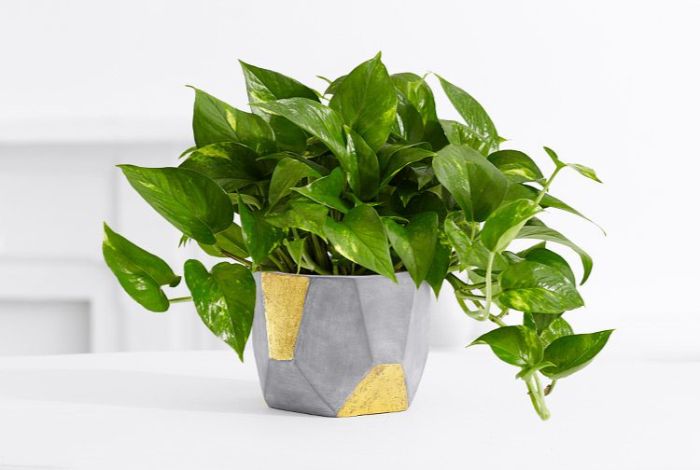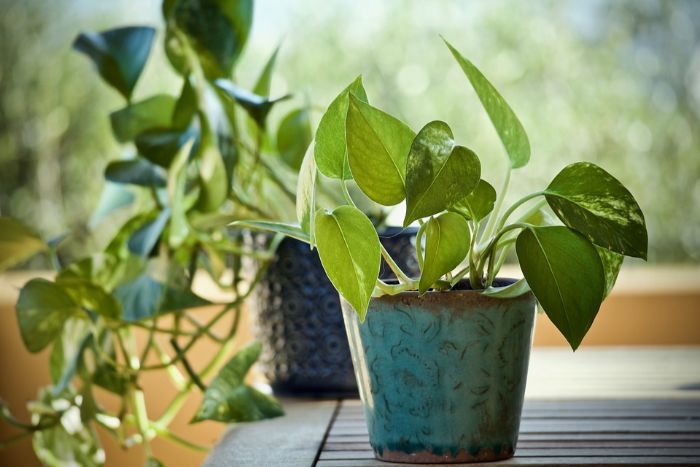If you’d like your Pothos (Epipremnum Aureum) to grow quickly and be as impressive as those you’ve seen in magazines and online, you might need a little help. Thankfully, you’ve come to the right place because I’ve got some great tips for you. This article will explain how to grow Pothos faster and ensure your plant is vibrant and healthy.
How do you grow Pothos faster? There are 6 ways you can speed up the growth of your Pothos:
- Use a nutritional growing medium.
- Provide sufficient bright, indirect sunlight.
- Keep room temperature between 70°F – 90°F.
- Don’t overwater – only water when the soil has dried out.
- Feed the plant with a balanced fertilizer every 2-3 months.
- Keep pests at bay.
Simply do the above 6 things right, and your Pothos can grow into an attractive focal point in your home. Below we discuss why Pothos make popular house plants and take a closer look at each of the 6 ways to grow a Pothos plant faster.
If you’d like to learn how to grow beautiful houseplants that thrive year after year, check out my book, “Houseplants Made Easy”.
Why Pothos Are Popular House Plants
Pothos are popular for their hardiness and durability and many people also like them due to their air cleaning characteristics (although the evidence for this is poor). These plants require minimal care and very rarely fall victim to disease.
Pothos house plants can be grown from cuttings, which means that you can use your one Pothos plant to grow several more. Also, they can be grown in either a soil medium or just in water.
For many, the Pothos is a number one choice because it is so easy to grow and very affordable too. With a variety of foliage patterns and colors to choose from, there’s a Pothos plant out there for everyone’s taste and preferences.
Why Is My Pothos Not Growing?
Sometimes you might feel that you are doing everything right, but your Pothos just is not growing as fast you had hoped it would. You might be wondering why your Pothos has stopped growing.
Stunted growth is a common problem with Pothos that aren’t happy in their living environment or how they are being treated. There are a number of reasons why your Pothos might not be growing fast (or at all). Below are a few reasons why your house plant might not be doing too well. I
- You are providing too much or too little water. Overwatering results in root rot while underwatering results in dehydration and shriveling up. Read this article to master the art of watering houseplants.
- Your home’s temperature is either above or below 50°F and 90°F. Pothos don’t like being too cold or too hot.
- The soil has a build-up of fertilizer in it.
- The potting soil lacks nutrients.
- The plant is exposed to too much sunlight or not enough sunlight. A shady spot or dark room is fine for a Pothos, as long as it gets some exposure to bright light. Read more about how to get the lighting right for your houseplants.

6 Ways to Grow Your Pothos House Plants Faster
Fast growth is often desired by those looking for a house plant to truly add decorative appeal and interest to the home. How you treat the plant will determine how quickly it grows and how impressive the plant will be. Read on to learn 6 ways to boost Pothos growth:
Use A Nutritional Growing Medium From The Start
How you start off with your new house plant is important. When you first get the plant, it will probably arrive young and in a smallish pot. As the plant grows, it will need to be repotted.
It is interesting to note that while Pothos can be grown in jars of water, their roots react negatively when they are potted in soil and overwatered. Water grown Pothos will grow, but not quite as quickly as Pothos that are grown in soil.
For the fastest growth, choose a standard, well-draining potting soil. This is a great potting mix for Pothos that will keep your plant thriving. Pothos enjoy a soil pH of 6.1 to 6.5 but they won’t have too much of an adverse reaction if the soil pH is a little outside this range.
When you plant your Pothos, take the time to choose a pot that has sufficient drainage. Healthy soil with a high nutritive value that drains well will boost the growth of any houseplant, not just Devil’s Ivy.
Provide Sufficient Bright, Indirect Sunlight
Devil’s Ivy needs a careful balance of light. While they need bright light, they cannot withstand direct sunlight for too long as the leaves tend to burn easily.
The best option is to place the plant in a position near a window where it can enjoy bright, indirect light. If you place the plant in a dark room or dark corner, the leaves will lose their variegation and the plant’s growth and health will suffer.
If the leaves start to turn pale, it could be an indication of receiving too much sunlight.
Keep Room Temperature Between 70°F And 90°F
Devil’s Ivy is native to the Solomon Islands and so it makes sense that it enjoys high humidity and temperatures that range between 70°F and 90°F. Make sure that the room where your house plant is situated is within this temperature range.
In these temperatures, they will flourish and grow quicker. The plant can withstand temperatures as low as 55°F, but anything below that and you will find your houseplant suffers stunted growth and leaves that start turning black.
Don’t Overwater – Only Water When The Soil Has Dried Out
Pothos plants require just the right amount of water. Planning a watering schedule can help you to avoid over or underwatering your house plant. Too much water can result in limp, wilted leaves. The leaves may even change to a yellow color.
These changes happen because the plant is prone to root rot when left to sit in waterlogged soil. One thing you can do to minimize the potential for root rot is to let the plant drain after watering and then empty the saucer beneath the pot.
Too little water can also have an adverse effect. It can result in the leaves curling and then becoming limp. The leaves may also drop off.
This particular plant likes the soil to dry out between watering. The roots can remain moist, but should not be allowed to be soaked between watering schedules. When the top 2 inches of soil have become dry, you can think about watering the plant again.
Feed The Plant With A Balanced Fertilizer Every 2-3 Months
Your Pothos plant can do just fine without being fertilized, especially if it has been potted in decent soil. However, fertilizing your Pothos every 2-3 months during the growing season will optimize growth rates and ensure your plant develops and matures as quickly as possible.
A balanced, water-soluble houseplant fertilizer is ideal. I’ve had really good results with this fertilizer that I use for my indoor plants. The quality is excellent and it’s easy to use. It won’t make your plants double in size overnight, but it does what its meant to very well.
If you aren’t sure if your soil needs fertilizer, you can test it. Most gardening stores sell home soil testing kits which can uncover exactly what nutrients are in the soil or lacking.
Most plants require 16 nutrients to flourish and grow. The primary nutrients required are potassium, nitrogen, and phosphorus. The secondary and micro nutrients needed are boron, cobalt, iron, zinc, molybdenum, copper, calcium, magnesium, and Sulphur. Most decent fertilizers will contain all of these elements.
Something interesting to know is that inorganic fertilizers provide an instant nutrient boost to soil which will spur on Pothos growth almost immediately. On the flip side, organic fertilizers may take longer to boost plant growth, but they ensure a healthier growing medium over the long term.
Of course, regardless of which fertilizer you choose, you will need to read the packaging information on the fertilizer and ensure that you use the correct amount for the pot size that your plant is living in.
Grow Pothos Faster By Keeping Pests At Bay
Just like any house plant, a Pothos that is attacked by pests can suffer stunted growth or damage to the delicate system of its leaves. Don’t get overly worried about insects though -pest infestation is rare with these particular house plants.
Bugs don’t often target Pothos, but those that sometimes do include the likes of caterpillars, scales, thrips, mites, and mealybugs.
If your plant seems to have contracted a few bugs and insects, you need to act quickly. You can remove each bug by wiping down the plant with a weak solution of rubbing alcohol and water.
You can also use an insecticide to rid a plant of bugs, insects and eggs. To make an environmentally friendly insecticide, mix 1 teaspoon of regular dishwashing liquid soap into a liter of water. Either wipe the plant down with this solution or use a spray bottle to apply it to the entire plant. Read my article on getting rid of houseplant bugs naturally for more information.
How To Get Pothos Cuttings To Grow Fast
If you want to propagate your own Pothos and get them growing fast, the process is fairly simple. Simply cut off stems of the plant to get your cuttings. Doing this will also encourage the main plant to become bushier or fuller. Follow these steps to grow your own Pothos cuttings fast:
- Cut pieces of stem between 6 and 12 inches long.
- Remove some of the leaves at the lower end of the stem. If you don’t, they will merely get in the way.
- Place the cuttings in a jar of water or a vase. You need to ensure that the last 2 or 3 nodes in the stem are completely submerged in water.
- Keep a close eye on the stems, making sure that you keep the bottom 3 nodes covered in water. Keep an eye out for new roots pushing through into the water. You can keep refreshing the water every 7 days or so.
- Keep doing this for at least 30 days after the first roots have appeared. After 30 days, your plant will have greater nutritional needs. Now is the time to transfer the cuttings to a soil medium. Plant the Pothos cuttings directly into pots and keep the soil lightly watered.
There are some house plant enthusiasts who have followed a similar growing technique, but have placed the fresh cuttings straight into light potting soil instead of jars of water. Some believe that the nutrients in the soil make the plant stronger and encourage faster growth from the start.
Last Word
The main way to grow Pothos faster is to provide it with the best growing conditions possible. By removing any restrictions to its growth, your Pothos can grow to its full potential.
If you want to learn more about growing indoor plants, check out my book, Houseplants Made Easy. It covers everything you need to know about growing houseplants, giving you the confidence and skills to grow beautiful plants. I cover each aspect of care, how to deal with common problems, and provide a simple guide to caring for 50 of the most popular indoor plants.

